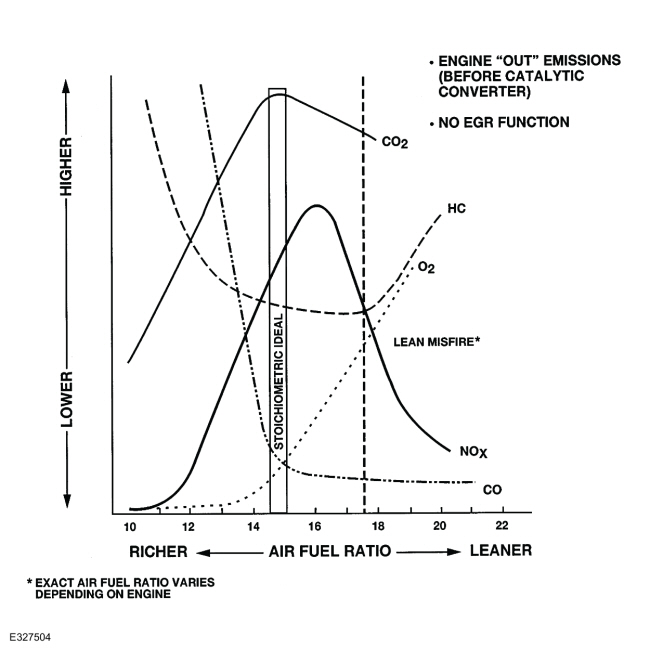Lincoln Navigator: Exhaust System - 3.5L EcoBoost (272kW/370PS) / Catalyst System. Diagnosis and Testing
Diagnostic Trouble Code (DTC) Chart
Diagnostics in this manual assume a certain skill level and knowledge of Ford-specific diagnostic practices.
REFER to: Diagnostic Methods (100-00 General Information, Description and Operation).
| Module | DTC | Description | Action |
|---|---|---|---|
| PCM | P0420:00 | Catalyst System Efficiency Below Threshold (Bank 1): No Sub Type Information | GO to Pinpoint Test HF |
| PCM | P0430:00 | Catalyst System Efficiency Below Threshold (Bank 2): No Sub Type Information | GO to Pinpoint Test HF |
Global Customer Symptom Code (GCSC) Chart
Diagnostics in this manual assume a certain skill level and knowledge of Ford-specific diagnostic practices.
REFER to: Diagnostic Methods (100-00 General Information, Description and Operation).
| Symptom | Action |
|---|---|
| Start/Run/Move > Running > Failed Emissions Testing > Catalyst | GO to Pinpoint Test EM |
| Start/Run/Move > Odor > Chemical > Always | GO to Pinpoint Test HF |
Pinpoint Tests

 PINPOINT TEST EM: EMISSION COMPLIANCE
PINPOINT TEST EM: EMISSION COMPLIANCE


  Introduction Introduction
NOTE: Canada and some states or metropolitan areas in the United States require periodic emission, or inspection/maintenance tests. All Ford products are designed to pass these tests. If a Ford product fails the test, the most likely causes are:
Normal Operation and Fault Conditions If any new emission components are installed, carry out the following steps before repeating the inspection/maintenance test procedure:

Verifying an excessive grams per mile (gpm) indication using a parts per million (ppm) reading. For excessive vehicle gas readings, compare the actual gpm reading to the gas cutpoint level needed to pass testing. This gives an indication of how much the ppm reading has to be reduced (if the actual reading is twice the cutpoint, the baseline reading has to be cut in half or more). Example:
Possible Sources
|

 PINPOINT TEST HF: CATALYST EFFICIENCY MONITOR AND EXHAUST SYSTEMS
PINPOINT TEST HF: CATALYST EFFICIENCY MONITOR AND EXHAUST SYSTEMS


  Introduction Introduction
Normal Operation and Fault Conditions Refer to the DTC Fault Trigger Conditions. DTC Fault Trigger Conditions
Possible Sources
|
 Exhaust System - System Operation and Component Description. Description and Operation
Exhaust System - System Operation and Component Description. Description and Operation
System Operation
Catalyst And Exhaust Systems
The
catalytic converter and exhaust systems work together to control the
release of harmful engine exhaust emissions into the atmosphere...
 Exhaust System. Diagnosis and Testing
Exhaust System. Diagnosis and Testing
Symptom Chart(s)
Symptom Chart: Symptom Chart - Exhaust System
Verify
the customer concern. Inspect the components of the exhaust system for
obvious signs of damage or other mechanical concerns using the following
chart...
Other information:
Lincoln Navigator 2018-2025 Workshop Manual: Evaporator. Removal and Installation
Removal NOTE: Removal steps in this procedure may contain installation details. Remove the climate control housing. Refer to: Climate Control Housing (412-00 Climate Control System - General Information, Removal and Installation)...
Lincoln Navigator 2018-2025 Workshop Manual: C Clutch. Diagnosis and Testing
Symptom Chart C Clutch For C clutch operation, REFER to: C Clutch (307-01 Automatic Transmission - 10-Speed Automatic Transmission – 10R80, Description and Operation). C Clutch Condition Possible Sources Action C clutch does not apply SSC mechanically stuck OFF INSTALL a new sole..
Categories
- Manuals Home
- 4th Gen Lincoln Navigator Service Manual (2018 - 2025)
- Windshield Washer Pump. Removal and Installation
- Transmission Fluid Level Check. General Procedures
- Transmission Fluid Drain and Refill. General Procedures
- Remote Function Actuator (RFA) Module. Removal and Installation
- Rear View Mirrors - System Operation and Component Description. Description and Operation
Wheel to Hub Runout Minimization. General Procedures
Check
NOTE: Wheel-to-hub optimization is important. Clearance between the wheel and hub can be used to offset or neutralize the Road Force® or run-out of the wheel and tire assembly. For every 0.001 inch of wheel-to-hub clearance, the Road Force® can be affected between 1 and 3 pounds depending on the tire stiffness.
NOTE: The example below illustrates how the clearance between the wheel and the hub can be used to offset the high spot of radial run-out or Road Force®. Following the procedure will make sure of the best optimization.
Position the wheel and tire assembly on the vehicle so that the high spot location of radial run-out or Road Force® is at the 6 o'clock position and